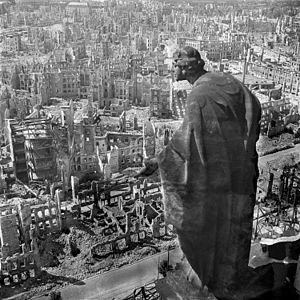The Destruction of Dresden facts for kids

Cover of the first edition
|
|
| Author | David Irving |
|---|---|
| Country | United Kingdom |
| Language | English |
| Subject | Bombing of Dresden in World War II |
| Publisher | William Kimber & Co. |
|
Publication date
|
1963 |
| Media type | Print (Hardcover and Paperback) |
| ISBN | 0705700305 |
| Followed by | The Mare's Nest |
The Destruction of Dresden is a book written in 1963 by British author David Irving. It tells the story of the bombing of Dresden in February 1945. This event happened during World War II when Allied forces bombed the German city.
When it was first published, the book became very popular around the world. It was part of a big discussion in the 1960s about whether it was right to bomb cities and their people during the war. Even though the book was once highly regarded, experts today do not consider it a trustworthy or accurate history of the Dresden bombing.
Contents
About the Book's Beginning
This book became a best-seller when it came out in the 1960s. It was based on a series of 37 articles David Irving wrote for a German magazine called Neue Illustrierte. These articles were titled Wie Deutschlands Städte starben, which means How Germany's Cities Died. They talked about the bombing strategies used during World War II.
How Many People Died in Dresden?

In the first version of his book, David Irving estimated a very high number of deaths. He wrote that the two attacks by the Royal Air Force and the first attack by the U.S. Army Air Forces "killed more than 135,000 people" in Dresden. He also suggested the number was likely between 100,000 and 250,000. In 1965, General Ira C. Eaker also mentioned the figure of 135,000 deaths.
For a long time, Irving's early numbers were widely accepted. Many history books and reference guides used them. However, in later versions of his book over the next 30 years, Irving slowly changed his estimates.
Changes in Death Toll Estimates
- In the 1971 edition, he wrote that the three raids "killed more than 100,000 people."
- By the 1995 edition, he stated the raids "cost the lives of between fifty and one hundred thousand inhabitants."
- Historian Richard J. Evans noted that Irving sometimes lowered the minimum number even more, saying the attack cost "up to a hundred thousand people their lives."
Why the Numbers Changed
According to historian Richard J. Evans, David Irving's early high estimates for the Dresden deaths came from only one person, Hans Voigt. Voigt did not provide any official documents to support his claims. He also used a document that had been faked by the Nazis. Voigt also claimed that a witness named Max Funfack was Dresden's Deputy Chief Medical Officer.
However, Max Funfack himself wrote a letter to Irving in 1965. In this letter, Funfack clearly stated that he was never the Chief or Deputy Chief Medical Officer in Dresden. He also said he had no knowledge of any official documents about the number of people killed in the bombing. During the war, he had only heard rumors, which varied greatly, about the death toll.
How the Book Influenced Other Writers
The famous writer Kurt Vonnegut used The Destruction of Dresden as a source for his 1969 novel, Slaughterhouse Five. Vonnegut himself saw the bombing of Dresden while he was a prisoner of war. He was in the basement of a slaughterhouse during the attacks. In his book, he wrote that after the bombing, he came out to find that "135,000 Hansels and Gretels had been baked like gingerbread men". This shows how Irving's early, higher numbers influenced other works of literature.

